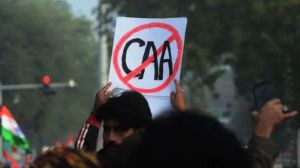The long march to nuclear capability
Forty years ago, China set India on a long march to its nuclear weapons. China’s first nuclear weapons test on October 16, 1964 had com...

Forty years ago, China set India on a long march to its nuclear weapons. China’s first nuclear weapons test on October 16, 1964 had come within two years after the Sino-Indian War in the high Himalayas. A lot of water has flown down the Brahmaputra since then. Relations between India and China are once again on the upward climb. Trade and economic relations are really shooting forward. Military-to-military contacts have been on the increase. The ‘‘problems left over from history’’ as the Chinese are fond of describing the territorial disputes remain unresolved. But bilateral agreements are in place to maintain peace and tranquility with mechanisms to ensure that its implementation is kept on track.
Looking back, it is clear that the 1960s had become extremely difficult for India, which was still struggling to feed itself. The trauma of that defeat in 1962 continues to affect Indian minds even though passage of time and improving relations have put a thin veil over it. After all, less than three years after China made and tested its bomb, it held out a threat to India during the 1965 War. Indians of that generation were deeply perplexed by this action since it also coincided with the American embargo on India which was the victim of military aggression by Pakistan.
The United States, incidentally, had sanctioned India in spite of Pakistan being the aggressor, and that too with American-supplied weapons which the US President had assured India would not be used against us! No wonder Moscow appeared to be the sole great power sensitive to Indian core interests.
Two years later, the Chinese Army fought a bitter engagement on the heights of Nathu La (in Sikkim), presumably to test Indian military strength and/ or resolve, where the Indian Army gallantly held the line. The frontiers remained peaceful for the following decades in spite of the hiccups of the Sumdorong Chu incident in 1987. The incident in effect provided the incentive for both to recast the bilateral relationship toward a deeper closeness which many people in the 1990s even started to interpret as a ‘‘strategic axis’’.
Historically, the two Asian giants adopted different approaches to nuclear science and technology. China went in for military application of nuclear technology first, and its development of nuclear technology for peaceful purposes would follow more than three decades later, spurred as it were, by its galloping demand for energy to sustain its remarkable economic growth. India on the other hand, gave primacy to nuclear technology for peaceful purposes and the weapons option was to be a last choice.
The result is that India is way ahead of China in nuclear technology that contributes to the well-being of people in medicine and healthcare, agriculture, water management, hydrology, industry, and now even the beginning of a nuclear desalination plant. But what worried the Indian leadership immediately after China acquired the bomb was how to ensure our security against a potential nuclear blackmail or actual threat and use.
Request to the British Prime Minister went unheeded. The next initiative was to work with the international community to try and get the nuclear weapon States to give up their weapons in return for the non-nuclear weapon States committing to remain non-nuclear. The promise of this grand bargain led to India co-sponsoring the NPT (Nuclear Non-Proliferation Treaty) passed unanimously by the UN General Assembly in November 1965. But the treaty as it emerged after negotiations was grossly skewed against the non-nuclear weapons States.
New Delhi made one more attempt to find an alternative for its security: security guarantees from Washington. But the Pentagon concluded that a mild statement instead of any guarantee would do! And India opted to stay out the NPT and pay the price for doing so. The rest is history.
But what is common to China and India, making them unique in the nuclear arena, is their nuclear doctrine for the employment of their weapons if the need ever arises. Both are committed to the strategy that they would not be the first to use nuclear weapons and would rely on credible deterrence through the promise of an assured retaliation. This has helped both to keep the nuclear genie well under control with a clear message to a would-be nuclear aggressor that it would suffer grievously if it embarked on a course of striking us first.



- 01
- 02
- 03
- 04
- 05




























